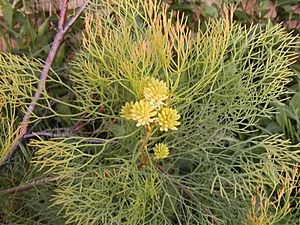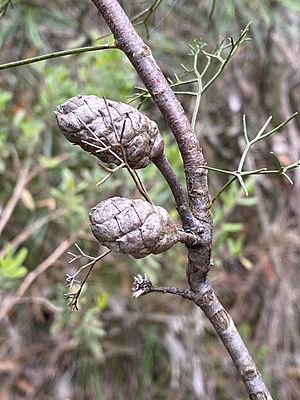Petrophile pedunculata facts for kids
Quick facts for kids Conesticks |
|
|---|---|
 |
|
| Petrophile pedunculata | |
| Scientific classification | |
| Genus: |
Petrophile
|
| Species: |
pedunculata
|
| Synonyms | |
|
|
Petrophile pedunculata, commonly known as conesticks, is a special flowering plant found only in New South Wales, Australia. It belongs to the Proteaceae plant family. This plant is called "conesticks" because its fruits look a bit like small cones on sticks! It has unique leaves that are divided into many needle-like parts. Its flowers are usually yellow or cream-colored and grow in oval-shaped clusters.
Contents
What Does the Conesticks Plant Look Like?
The conesticks plant is a shrub that can grow quite tall, up to about 2.5 meters (that's like two and a half average-sized bikes stacked up!). Its branches and leaves are smooth, meaning they don't have any hairs.
Leaves and Stems
The leaves are very interesting! They are long, usually between 7 and 18.5 centimeters. They have a main stem called a petiole, which is about 2.5 to 9.5 centimeters long. From this main stem, smaller needle-shaped parts branch out. These smaller parts are called pinnae and are usually less than 2 centimeters long. Even though they are needle-shaped, they aren't sharp!
Flowers and Fruit
The flowers of the conesticks plant are small, about 7 to 10 millimeters long. They are yellow or cream-colored and have a few soft hairs. These flowers grow in oval-shaped clusters, about 1 to 1.5 centimeters long. Each cluster sits on a small stalk called a peduncle, which is also about 1 to 1.5 centimeters long.
You can usually see conesticks flowering from October to January. After the flowers, the plant produces a type of fruit called a nut. These nuts are joined together in an oval-shaped head that can be up to 4 centimeters long. This fruit head also sits on a peduncle, which is about 2 centimeters long.
How to Tell Conesticks Apart
Conesticks can look a bit like another plant called Petrophile pulchella. But there's a simple way to tell them apart! P. pulchella has flower heads that are either directly attached to the stem (which means they are sessile) or have very short peduncles, less than 1 centimeter long. Conesticks, on the other hand, always have flower heads on longer peduncles, usually 1 to 1.5 centimeters long.
How Conesticks Got Its Name
The scientific name for this plant, Petrophile pedunculata, was first officially written down in 1810. A famous botanist named Robert Brown described it. He found samples of the plant near a place called Port Jackson in New South Wales. He published his description in a scientific book called the Transactions of the Linnean Society of London.
Where Do Conesticks Grow?
Conesticks plants like to grow in places where the soil is shallow and sandy, especially on sandstone. You can often find them in open forests or areas with heathlands.
They are quite common along the coast of New South Wales. You can spot them between Port Jackson and a town called Milton. They also grow in the mountain ranges, like the Blue Mountains and near Marulan.


